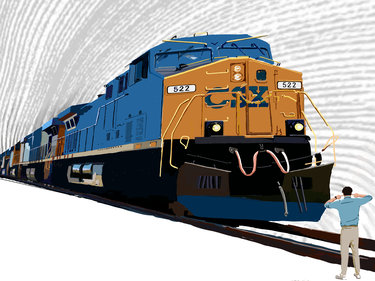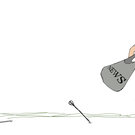Railroads are blasting past human health concerns
For a business, the bottom line is cost. The most important consideration is making a profit.
For government, the most important consideration is — or should be — public welfare.
One of our local governments — the village of Voorheesville — has public welfare front and center in its pursuit of a quiet zone for two railroad crossings in town.
As a model example of how government should work, a citizens’ committee was formed in 2012, headed by Steven Schreiber, to advocate for the gated system that would allow trains to pass safely through the village without blasting their horns.
The committee cited impacts caused by the blast of train horns on local businesses attempting to develop Main Street; on potential decreases in property values; and on public-health concerns, particularly the noise at a nearby playground.
Not only did the village government get on board, it enlisted the Albany County government, which owns the two roads crossed by the tracks, and the state government, which provided grant money for the project, expected to cost $400,000.
Our New Scotland reporter, Sean Mulkerrin, has detailed more than a decade of various obstacles which these governments worked to overcome to bring this project to fruition.
Just as the last hurdle was cleared and the end goal of a peaceful village was in sight, rail giant CSX Transportation has stalled the project indefinitely over two demands: requiring tens of thousands of dollars in annual maintenance fees and requiring the county to take on liability costs.
Earlier this month, we published Mulkerrin’s exhaustive account that recounted Voorheesville’s persistent efforts to prevail and also looked at other municipalities nationwide that have been similarly foiled in their efforts.
It is clear that the national government must get involved to better regulate this David-versus-Goliath battle if public welfare is to prevail.
After Mulkerrin’s story ran on our website, we heard from Scott Murff of Lehi, Utah, founder of the National Quiet Zone Association. Just as Schreiber lives near the tracks in Voorheesville, Murff, a professor at Brigham Young University and a former federal regulator, lives near the tracks in Lehi.
When Murff purchased his house, the nearby crossing had a quiet zone and he slept soundly. But, when the Federal Railroad Administration in 2024 unexpectedly suspended that quiet zone and others in Utah, saying some of the zones were not in compliance, Murff could no longer get a good night’s sleep.
With his background as a federal regulator as well as being a longtime consultant who had helped companies respond to regulatory mandates, Murff founded the association, which he says is working with Congress members to make changes, and delved into doing research.
His association, similar to Schreiber’s committee, asserts that quiet zones improve quality of life especially in residential areas; increase property values; encourage economic development, making areas more appealing to businesses and tourists; and improve public health and safety since excessive noise is linked to health issues, including stress, cardiovascular problems, and sleep disturbances.
This week, Voorheesville resident Steve Greenberg has written us with calculations to show that annual quiet-zone maintenance fees would be covered by increased home values and the taxes they pay.
Murff’s research paper asks the question, “Do nighttime train horns hurt more than help?” He explains the history of quiet zones beginning with efforts in Florida in the 1970s to put safety features at railroad crossings so horns needn’t be sounded at night.
The Federal Railroad Association, an agency of the federal Department of Transportation, studied the accidents at those crossings and found that train whistles were a more effective accident deterrent, leading to a 1991 rule requiring train whistles to be reinstated.
After a law was passed by Congress, the association’s final rule, in 2005, requires trains to sound their horns at all at-grade crossings day and night unless the requirements of a “Quiet Zone” are met.
“The required upgrades are typically cost prohibitive,” Murff writes, noting in the 20 years since the final rule was established, just 3 percent of active train crossings in the United States have qualified for quiet-zone status.
Murff includes an extensive review of studies worldwide that document health problems caused by sleep loss. One 2010 meta-analysis of 16 sleep-loss studies found an “unambiguous and consistent pattern of increased risk of dying” from short sleep, estimating a 12-percent increase in risk of death.
The World Health Organization has stated, “In 2011, an estimated one million healthy life years were lost from traffic-related noise in the western part of Europe only. Important sources for environmental noise exposure are road, railway and air traffic, or building sites … research shows it increases the risk for IHD [ischemic heart disease] and hypertension, sleep disturbance, hearing impairment, tinnitus and cognitive impairment, with increasing evidence for other health impacts such as adverse birth outcomes and mental health problems.”
The bulk of Murff’s 18-page paper consists of copious calculations meant to illustrate that the sounding of train horns over the last five years has caused more deaths than their silencing. He stresses that the Florida policy study on which current regulations are based focused only on the benefits of nighttime train horns, not on the cost to human lives.
Regardless, Voorheesville’s proposal for a four-quadrant quiet-zone system at each of the two crossings meets all the requirements set forth in the Federal Railroad Association’s final rule.
Unlike standard two-gate systems, four-quadrant gates, as planned for Voorheesville, block all lanes of traffic on both sides of the track, physically preventing vehicles from driving around lowered gates.
As Schreiber correctly points out, this proposal is safer than the current sounding of train horns.
“Only CSX has the knowledge and expertise to build, operate, and maintain the additional gates needed for the quiet zone,” Schreiber wrote to us this month. “In view of the fact that the operation of the quiet zone would be completely under the control of CSX, how can CSX argue that some other party should be liable for what might occur at that crossing?”
Schreiber’s point is spot on.
Municipalities like Voorheesville that are willing to bear the costs of setting up quiet zones to meet the federal requirements should not then be thwarted by exorbitant costs from railroad companies for liability and maintenance.
Even if the annual maintenance fees can be covered as Greenberg calculates, the potential financial exposure for liability can be immense, with figures like $200 million per accident per crossing cited as a benchmark in Plymouth, Michigan.
Securing adequate insurance is difficult and costly, as Mulkerrin noted, since standard municipal policies often exclude quiet zones. Specialized coverage from limited markets comes with high premiums (Plymouth faced estimates of $100,000 to $200,000 annually), potentially doubling a city’s total liability costs and possibly still not covering the full perceived exposure.
Railroads should maintain their own infrastructure as a cost of doing business and they should also be liable for any accidents that occur after a municipality has properly followed the regulations in establishing a quiet zone.
The law passed by Congress was meant to let municipalities like Voorheesville set up quiet zones.
The Goliath of big business, motivated by profit, should not be allowed to trump the public welfare that the David of small government is entitled to. The Federal Railroad Association should see to that.
Millions of Americans would sleep easier and, if Murff’s calculations are correct, live longer.


